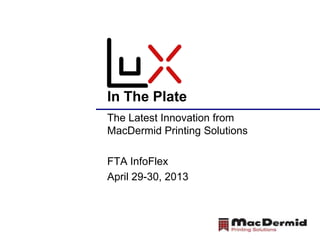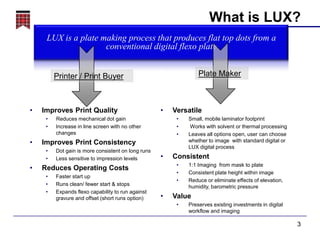Fta 2013 LUX itp v1.0
- 1. In The Plate The Latest Innovation from MacDermid Printing Solutions FTA InfoFlex April 29-30, 2013
- 2. Enabling higher quality print 2
- 3. 33 What is LUX? LUX is a plate making process that produces flat top dots from a conventional digital flexo plate âĒ Improves Print Quality âĒ Reduces mechanical dot gain âĒ Increase in line screen with no other changes âĒ Improves Print Consistency âĒ Dot gain is more consistent on long runs âĒ Less sensitive to impression levels âĒ Reduces Operating Costs âĒ Faster start up âĒ Runs clean/ fewer start & stops âĒ Expands flexo capability to run against gravure and offset (short runs option) Printer / Print Buyer âĒ Versatile âĒ Small, mobile laminator footprint âĒ Works with solvent or thermal processing âĒ Leaves all options open, user can choose whether to image with standard digital or LUX digital process âĒ Consistent âĒ 1:1 Imaging from mask to plate âĒ Consistent plate height within image âĒ Reduce or eliminate effects of elevation, humidity, barometric pressure âĒ Value âĒ Preserves existing investments in digital workflow and imaging Plate Maker
- 4. 4 LUX: It is that simple Existing process LUX process Ablate Plate Digital Plate Expose Process Plate Standard Digital Plate Mem brane Remove Membrane LUX Lamination
- 5. LUX Dot Formation UV UV UV O2 O2
- 6. Optimizing Dot Profile âĒ Lots of dots work. Some dots work better. â These factors seem to matter most 6 Dot Surface Morphology Shoulder AngleValley DepthEdge definition Dot Surface
- 7. Standard Digital vs LUX Digital âĒ Edge definition is far greater for LUX digital âĒ Surface roughness is little changed Standard digital exposure LUX digital exposure
- 8. Industry Recognition LUXTM flat top dot technology WINS FFTAâs 2011 Award for Innovation 8 LUX also won the 2011 FPPA Innovator Award
- 9. Global Adoption of LUX 150+ Worldwide Installations
- 11. Better Highlights 11 1% 5% 10% Digital Digital Digital Digital Digital Digital
- 12. Sweflex 2013 Print Trial 12
- 13. Highlights 13 Better small dots, better highlight color and detail.
- 14. LUX & HD Flexo/MicroCell Standard digital SID = 1.21 Mottle = 17.8 LUX / MC16P SID = 1.35 Mottle = 4.2
- 15. MC12P vs MC12P-LUX 100 âĒ Edge definition is much sharper with LUX âĒ MicroCell pattern is much sharper with LUX Standard digital exposure LUX digital exposure
- 16. LUX makes MicroCell work better 16 1.20 1.30 1.40 1.50 1.60 1.70 1.80 Solid MC7 MC1 MC8 MC9 MC10 MC4 MC11 MC12 MC3 MC13 MC14 MC15 MC16 MC5 MC6C MC6 MG14 MG24 MG34 MG15 MG25 MG35 MG45 MG16 MG26 MG36 MG46 MG56 MC17 MC18 MC19 MC20 SIDcyan Microcell Pattern DMAX Microcell Effects DMAX DMAX LUX Higher ultimate SID with LUX, and more patterns work.
- 18. 18 Consistency: Impression Latitude LUX enables flexo printers to print with greater consistency Dot gain is less sensitive to impression -Fewer stops for adjustment -Longer runs 0 10 20 30 40 50 60 70 80 90 100 110 0 10 20 30 40 50 60 70 80 90 100 Digital MVP Digital MVP + 6mil (150 um) 0 10 20 30 40 50 60 70 80 90 100 110 0 10 20 30 40 50 60 70 80 90 100 Digital MVP + LUX Digital MVP + LUX + 6mil (150 um) Standard Digital Standard Digital + LUX 0 10 20 30 40 50 60 70 80 90 100 110 0 10 20 30 40 50 60 70 80 90 100 Digital MVP Digital MVP + 6mil (150 um) 0 10 20 30 40 50 60 70 80 90 100 110 LUX reduces dot gain from impression 30 - 60% Improvement
- 19. Consistency: Effects of Wear âĒ Improves Print Consistency â Dot gain was more consistent during this long run 19 Some evidence of wear in the plateâĶâĶ.. But not in the print Example Digital MAX (high hardness) 0.107 in plates (2.72mm) 890k linear foot (271k meters) Press: W&H Novaflex Anilox: 900 LS / 2.2 bcm Ink: Solvent Substrate: Film
- 20. Versatility - Platemaking âĒ It works on all MacDermid digital plates â Works with plates up to 50â x 80â size â Works with plates from 0.045â to 0.250â thickness âĒ It adds <5 minutes to a normal digital workflow âĒ Backwards-compatible â Use LUX when needed, use standard digital workflow for legacy jobs 20
- 21. 21 The Next Next Step in Flexo Printing
- 22. 22 LUX ITP: Itâs even simpler Ablate Plate Digital Plate Expose Process Plate Standard Digital Plate LUX ITP Digital Plate
- 23. LUX ITP Solvent 23 0 10 20 30 40 50 60 70 80 90 100 0 10 20 30 40 50 60 70 80 90 100 Print Tone DMAX M100 S LUX ITP S Note: Printed with linear tone scale, 150 lpi
- 24. LUX ITP Thermal 24 0 10 20 30 40 50 60 70 80 90 100 0 10 20 30 40 50 60 70 80 90 100 Print Tone DMAX M100 T LUX ITP T Note: Printed with linear tone scale, 150 lpi
- 25. A Comparison LUX Lamination âĒ Produces LUXâĒ dots âĒ Enhances MicroCell screening âĒ 1% 200 lpi âĒ Works with all MacDermid digital plates âĒ Surface texture available through Membrane 200 âĒ Uses LUX laminator LUX ITP âĒ Produces LUXâĒ dots âĒ Enhances MicroCell screening âĒ 1% 150 lpi (so farâĶ) âĒ Special plate required â 60d uncapped âĒ No surface texture âĒ No lamination required 25
- 26. LUX ITP â The Future âĒ First LUX ITP plate (60d uncapped) will be commercialized in 2013 26
- 27. Industry Perspective in 2013 Flat top dots are important, butâĶ 1.Are they all the same? 2.What is the best way to make them? 27
- 28. ConeAnalog Compound Not all Flat Top Dots are Equivalent DigitalKodak NX DigiFlow Esko FTD Flint NExT
- 29. Our Proposition 29 Solvent Thermal Digital Dot TypeProcessing Technology We offer you more choices. We are the Global Leader in Flat Top Dot Solutions. We have the expertise to help you make the most of the options you select.
- 30. Thank You 30 http://www.macdermid.com/printing Follow us on:Learn more at:





























